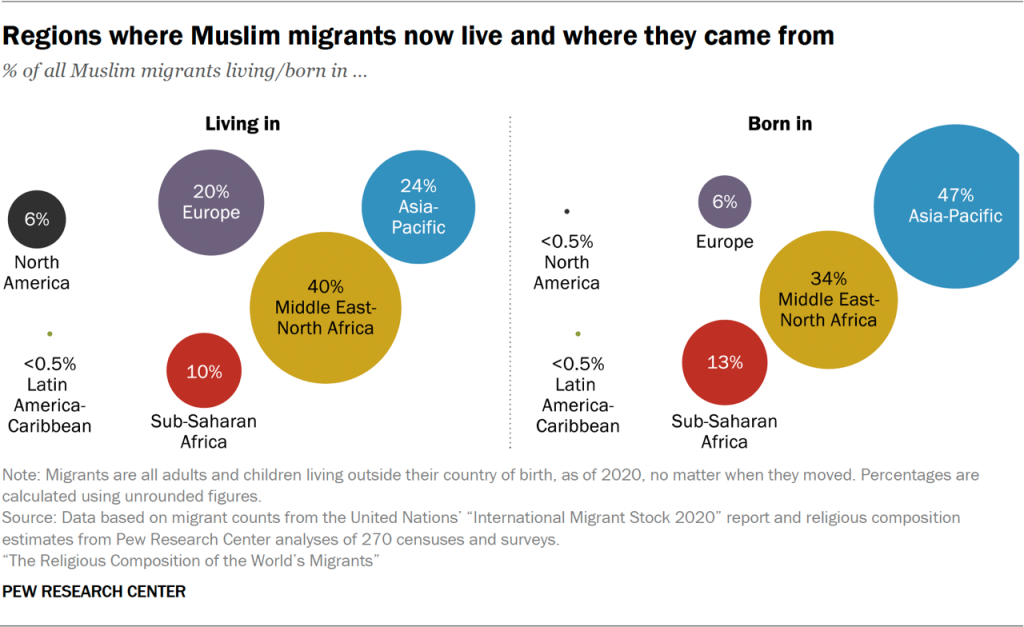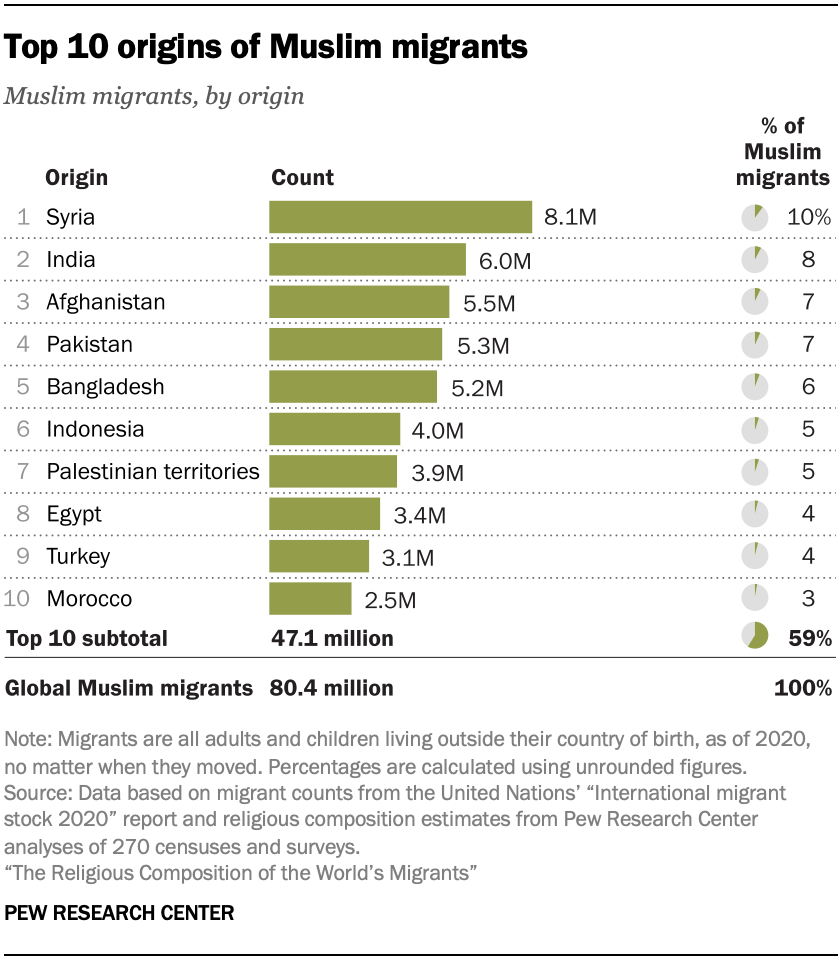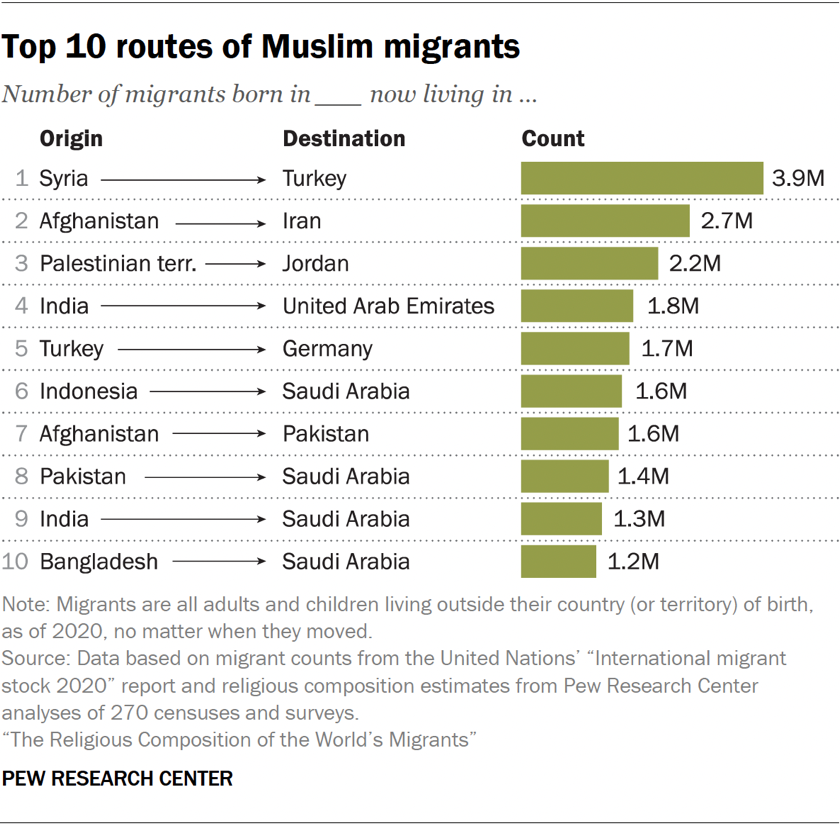The United Nations counts international migrants as people of any age who live outside their country (or in some cases, territory) of birth – regardless of their motives for migrating, their length of residence or their legal status.
In addition to naturalized citizens and permanent residents, the UN’s international migrant numbers include asylum-seekers and refugees, as well as people without official residence documents. The UN also includes some people who live in a country temporarily – like some students and guest workers – but it does not include short-term visitors like tourists, nor does it typically include military forces deployed abroad.
For brevity, this report refers to international migrants simply as migrants. Occasionally, we use the term immigrants to differentiate migrants living in a destination country from emigrants who have left an origin country. Every person who is living outside of his or her country of birth is all three – a migrant, an immigrant and an emigrant.
The analysis in this report focuses on existing stocks of international migrants – all people who now live outside their birth country, no matter when they left. We do not estimate migration flows – how many people move across borders in any single year.
Roughly 80 million international migrants are Muslim, representing 29% of all people living outside their country of birth. By comparison, Muslims were about 25% of the world’s total population in 2020, making Muslim identity a little more common among migrants than in the overall population.14
Muslims have moved shorter distances on average (1,700 miles) than migrants from other major religious groups, staying closer to their countries of origin. For example, large numbers of Muslims from Syria have sought refuge in nearby Turkey and Lebanon.
Muslim migrants most commonly live in the Middle East-North Africa region, which hosts 40% of them, and in the Asia-Pacific region (24%). Two-in-ten Muslim migrants live in Europe, and one-in-ten are in sub-Saharan Africa. Only 6% of all Muslim migrants now reside in North America, and even fewer live in Latin America and the Caribbean.
As of 2020, almost half of the world’s stock of Muslim migrants was born in Asia and the Pacific, the most common region of origin for Muslims who have left their country of birth. About a third of today’s Muslim migrants were born in the Middle East and North Africa, and 13% are from sub-Saharan Africa. Smaller percentages of Muslim migrants originated in Europe (6%), North America or the Latin America-Caribbean region (less than 0.5% each).

Destinations
Muslims most commonly move to countries that are wealthy, predominantly Muslim, or both.

They have migrated to many different regions: Four of Muslims’ top 10 destinations are in the Middle East and North Africa, two are in Europe, three are in Asia and the Pacific, and one (the United States) is in North America.
Saudi Arabia, the birthplace of Islam, is the most common destination country for Muslim migrants by a wide margin, with an estimated 13% of all Muslim migrants (10.8 million) living there.
The Saudi kingdom also is the third-most common destination for migrants overall – roughly four-in-ten Saudi residents are foreign born. The vast majority of migrants to Saudi Arabia are Muslim (80%), as is Saudi Arabia’s overall population (93%).
The United Arab Emirates hosts over 6 million foreign-born Muslims, making it the second-most popular destination for Muslim migrants. Like Saudi Arabia, the UAE is a wealthy Muslim nation with a strong demand for foreign labor. International migrants overall make up the vast majority of the UAE’s population (94%).
Muslim migrants in Saudia Arabia and the UAE most frequently come from India.
Turkey is the third-most common destination for Muslim migrants (5.9 million) as of 2020. Turkey has been economically better off than many of its neighbors and has absorbed a large number of asylum-seekers since the Syrian civil war began in 2011. Mostly due to this influx, there were about six times as many Muslim migrants living in Turkey in 2020 as there had been a decade earlier.
The next most popular destinations for Muslim migrants are Germany and the U.S.
Origins
Like migrants as a whole – who gravitate to places that offer safety and better economic conditions – Muslim migrants often leave their birth countries to escape poverty and danger.

The most common country of origin for Muslim migrants is Syria, where a war broke out in 2011. Fully 10% of the world’s stock of Muslim migrants (8.1 million) were born in Syria. Most have migrated to countries nearby, like Turkey and Lebanon, while some have gone as far as Europe and the U.S.
India is the second-most common country of origin among Muslim migrants, with 6.0 million living there. They are much more likely than people in the country’s Hindu majority to emigrate. Although India’s population is only 15% Muslim, an estimated 33% of all India-born migrants are Muslim.
Most Muslim migrants from India live in Muslim-majority countries with job opportunities, including the UAE (1.8 million), Saudi Arabia (1.3 million) and Oman (720,000).
Afghanistan is the third-most common origin country for Muslim migrants (5.5 million). A majority of Muslim migrants from Afghanistan live in neighboring Iran (2.7 million) or Pakistan (1.6 million). Migrants from Afghanistan have fled challenging conditions over the decades, including an occupation by the Soviet Union in the 1980s and a U.S.-led invasion in the early 2000s.
Country pairs
The most common pair of origin and destination countries for Muslim migrants is Syria to Turkey. About 3.9 million Syrian Muslims, including many war refugees, now live in Turkey.

The next most common routes for Muslims have been Afghanistan to Iran (2.7 million), and the Palestinian territories to Jordan (2.2 million).15
Change since 1990
The Muslim migrant population grew from 40 million in 1990 to 80 million in 2020 (up 102%), outpacing overall migrant growth (up 83%).
Saudi Arabia, the UAE and Turkey have seen the biggest jumps since 1990, with 16.8 million additional Muslim migrants in those three countries alone as of 2020 (a 278% rise). Saudi Arabia and the UAE have had booming economies over these years, while Turkey has seen increased migration primarily from Syria.
Elsewhere, the Muslim migrant population has declined. The number of Muslim migrants living in Pakistan dropped from 4.1 million in 1990 to 2.1 million in 2020 (a 50% drop), partly reflecting the return of Afghan migrants to their home country. During the same three decades, Iran’s population of foreign-born Muslims declined from 4.3 million to 2.8 million (down 35%).
Of all origin countries, Syria accounted for the biggest surge in Muslim migrants by far, from 570,000 in 1990 to 8.1 million in 2020, a rise of about 1,300%.
India and Pakistan also have seen sharp increases, as more and more Muslim migrants have left South Asia for work in the Persian Gulf. The worldwide stock of Muslim migrants from India grew from 2.1 million to 6 million (up 192%), while the number from Pakistan rose from 1.8 million to 5.3 million (up 202%).
The largest decrease by origin came from Afghanistan, which was the birth country of 7.4 million Muslim migrants living elsewhere in 1990, compared with 5.5 million in 2020 (down 26%). This difference reflects return migration to Afghanistan as well as the gradual death of a generation of Afghans who left their country during the Soviet occupation.
Refer to our “Geographic spotlights” section for an in-depth analysis of migration in the GCC countries.




